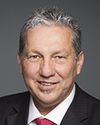Thank you, Madam Chair.
Thank you to the standing committee for your invitation.
The Canadian Labour Congress is the largest labour organization in Canada, with 56 affiliated Canadian and international unions, provincial federations of labour, and regional labour councils. The CLC represents 3.3 million workers across all private and public sectors. Indigenous workers, racialized workers, and workers of all faiths are a growing and important part of our labour movement, and any attack on them is an attack on us all. As trade unionists, the CLC and its affiliates continue to stand strong in solidarity to eradicate the forces of hate, racism, and discrimination that divide us.
Systemic racism and discrimination in Canada is well and alive. In 2015, 48% of police reports showed that hate crimes were motivated by hatred of a race or ethnicity, and 35% were motivated by hatred of a religion. Between 2014 and 2015, police reported hate crimes rose by 5%, mainly attributable to the increase of racial and religious hate-related crimes.
The unprecedented rise of Islamophobia and religious discrimination in Canada is very disturbing. There have been attacks on Muslim women wearing hijabs, vandalism of mosques, threats and verbal abuse, numerous anti-Islam and anti-Muslim protests, and anti-racist, anti-fascist counter-protests across Canada.
Most horrifying of all was the terrorist gun attack on the Centre culturel islamique de Québec during evening prayers on January 29, 2017, that left six Muslim worshippers dead and 19 injured. The labour movement condemns in the strongest possible terms any acts of violence against Muslims.
Religious hate crimes against women rose between 2014 and 2015 due to the increase in victimization of Muslim as well as Jewish women.
The very recent Bill 62 in Quebec will likely worsen matters. Bill 62 ostensibly ensures religious neutrality, but de facto it's an attack on the rights of Muslim women who cover their face from receiving or delivering public services. The particularly gendered exclusionary impact of this bill is discriminatory. It is also wrong to ask workers providing public services to participate in the violation of rights that are promised to every Canadian under the Charter of Rights and Freedoms, as well as provincial human rights codes. We must stand up against Islamophobia and categorically reject policies that discriminate against people of the Muslim faith.
Racism and discrimination have no place in our unions, in our communities, or in our country. Today indigenous people, as well as black and racialized Canadians, are still more likely to be carded, under surveillance, and incarcerated. There have been anti-immigrant flyers and protests targeting Chinese and Sikh communities, police violence and shootings of black Canadians and indigenous people, and racist epithets hurled at racialized Canadians in public.
Muslim and racialized Canadians, as well as indigenous people, continue to experience employment discrimination, wage disparities, and lack of opportunities, in particular if they are women, live with a disability, and/or are LGBTQ. They continue to be the most impoverished in Canada.
Lastly, even Canada's low-wage streams of the temporary foreign worker program systemically discriminate against racialized workers from poorer countries in the south by weakening their rights through tied employer work permits and offering little hope of Canadian citizenship. These developments project urgency and compel us to act with even more fortitude.
At the CLC convention in May, 3,500 union delegates affirmed our commitment to pursue public policies that respect the dignity and rights of all working people regardless of race, religion, immigration status, or country of origin. With our affiliates, we are committed to educating the rank and file to inoculate them against right-wing populism, and we are ready to assist the government to better make diversity our country's strength.
We also have seven recommendations for the standing committee.
First, the government has to immediately implement the 94 recommendations of the Truth and Reconciliation Commission of Canada and the United Nations Declaration on the Rights of Indigenous Peoples. This also includes government actions to support the ongoing work of the National Inquiry into Missing and Murdered Indigenous Women and Girls and develop a strategy and prioritize the implementation of the inquiry's findings and recommendations.
Second, reinstate Canada's action plan against racism to activate a whole-of-government approach to reducing or eliminating systemic racism and religious discrimination. This would help Canada comply with the requirements of the UN World Conference Against Racism.
Third, the government must repeal the effects of legislation that characterizes or insinuates racist stereotypes and propagates fear in Canada, specifically the Conservatives' Bill C-51, the Anti-terrorism Act, and Bill S-7, the Zero Tolerance for Barbaric Cultural Practices Act. These should be repealed.
Fourth, the government must strengthen the federal Employment Equity Act and program, reinstate the $200,000 government contract threshold for the federal contractors program, and restore mandatory compliance requirements equivalent to the Employment Equity Act itself.
Fifth, immediately introduce proactive pay equity legislation that will close the wage disparity, in particular for racialized Muslim, black, and indigenous women.
Sixth, the government should increase funding to support anti-racism and anti-oppression programs.
Seventh, the government should collect disaggregated data by ethno-racial and religious background across all departments, crown corporations, and other relevant institutions for better analysis and evidence-based policy-making, to eradicate systemic racism and discrimination.
I thank you for the opportunity to present, and I look forward to your questions.
Whichever language you would like to ask them in is fine with me.
Thank you.



